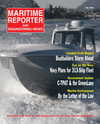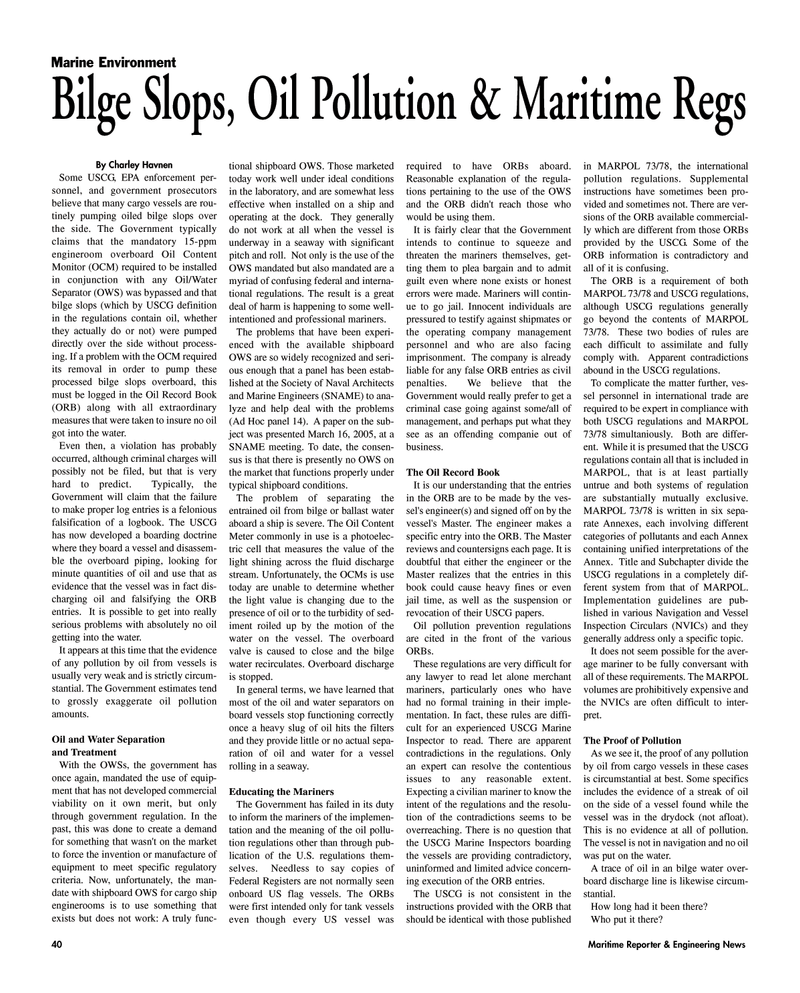
Page 40: of Maritime Reporter Magazine (May 2006)
The Marine Enviroment
Read this page in Pdf, Flash or Html5 edition of May 2006 Maritime Reporter Magazine
40 Maritime Reporter & Engineering News
By Charley Havnen
Some USCG, EPA enforcement per- sonnel, and government prosecutors believe that many cargo vessels are rou- tinely pumping oiled bilge slops over the side. The Government typically claims that the mandatory 15-ppm engineroom overboard Oil Content
Monitor (OCM) required to be installed in conjunction with any Oil/Water
Separator (OWS) was bypassed and that bilge slops (which by USCG definition in the regulations contain oil, whether they actually do or not) were pumped directly over the side without process- ing. If a problem with the OCM required its removal in order to pump these processed bilge slops overboard, this must be logged in the Oil Record Book (ORB) along with all extraordinary measures that were taken to insure no oil got into the water.
Even then, a violation has probably occurred, although criminal charges will possibly not be filed, but that is very hard to predict. Typically, the
Government will claim that the failure to make proper log entries is a felonious falsification of a logbook. The USCG has now developed a boarding doctrine where they board a vessel and disassem- ble the overboard piping, looking for minute quantities of oil and use that as evidence that the vessel was in fact dis- charging oil and falsifying the ORB entries. It is possible to get into really serious problems with absolutely no oil getting into the water.
It appears at this time that the evidence of any pollution by oil from vessels is usually very weak and is strictly circum- stantial. The Government estimates tend to grossly exaggerate oil pollution amounts.
Oil and Water Separation and Treatment
With the OWSs, the government has once again, mandated the use of equip- ment that has not developed commercial viability on it own merit, but only through government regulation. In the past, this was done to create a demand for something that wasn't on the market to force the invention or manufacture of equipment to meet specific regulatory criteria. Now, unfortunately, the man- date with shipboard OWS for cargo ship enginerooms is to use something that exists but does not work: A truly func- tional shipboard OWS. Those marketed today work well under ideal conditions in the laboratory, and are somewhat less effective when installed on a ship and operating at the dock. They generally do not work at all when the vessel is underway in a seaway with significant pitch and roll. Not only is the use of the
OWS mandated but also mandated are a myriad of confusing federal and interna- tional regulations. The result is a great deal of harm is happening to some well- intentioned and professional mariners.
The problems that have been experi- enced with the available shipboard
OWS are so widely recognized and seri- ous enough that a panel has been estab- lished at the Society of Naval Architects and Marine Engineers (SNAME) to ana- lyze and help deal with the problems (Ad Hoc panel 14). A paper on the sub- ject was presented March 16, 2005, at a
SNAME meeting. To date, the consen- sus is that there is presently no OWS on the market that functions properly under typical shipboard conditions.
The problem of separating the entrained oil from bilge or ballast water aboard a ship is severe. The Oil Content
Meter commonly in use is a photoelec- tric cell that measures the value of the light shining across the fluid discharge stream. Unfortunately, the OCMs is use today are unable to determine whether the light value is changing due to the presence of oil or to the turbidity of sed- iment roiled up by the motion of the water on the vessel. The overboard valve is caused to close and the bilge water recirculates. Overboard discharge is stopped.
In general terms, we have learned that most of the oil and water separators on board vessels stop functioning correctly once a heavy slug of oil hits the filters and they provide little or no actual sepa- ration of oil and water for a vessel rolling in a seaway.
Educating the Mariners
The Government has failed in its duty to inform the mariners of the implemen- tation and the meaning of the oil pollu- tion regulations other than through pub- lication of the U.S. regulations them- selves. Needless to say copies of
Federal Registers are not normally seen onboard US flag vessels. The ORBs were first intended only for tank vessels even though every US vessel was required to have ORBs aboard.
Reasonable explanation of the regula- tions pertaining to the use of the OWS and the ORB didn't reach those who would be using them.
It is fairly clear that the Government intends to continue to squeeze and threaten the mariners themselves, get- ting them to plea bargain and to admit guilt even where none exists or honest errors were made. Mariners will contin- ue to go jail. Innocent individuals are pressured to testify against shipmates or the operating company management personnel and who are also facing imprisonment. The company is already liable for any false ORB entries as civil penalties. We believe that the
Government would really prefer to get a criminal case going against some/all of management, and perhaps put what they see as an offending companie out of business.
The Oil Record Book
It is our understanding that the entries in the ORB are to be made by the ves- sel's engineer(s) and signed off on by the vessel's Master. The engineer makes a specific entry into the ORB. The Master reviews and countersigns each page. It is doubtful that either the engineer or the
Master realizes that the entries in this book could cause heavy fines or even jail time, as well as the suspension or revocation of their USCG papers.
Oil pollution prevention regulations are cited in the front of the various
ORBs.
These regulations are very difficult for any lawyer to read let alone merchant mariners, particularly ones who have had no formal training in their imple- mentation. In fact, these rules are diffi- cult for an experienced USCG Marine
Inspector to read. There are apparent contradictions in the regulations. Only an expert can resolve the contentious issues to any reasonable extent.
Expecting a civilian mariner to know the intent of the regulations and the resolu- tion of the contradictions seems to be overreaching. There is no question that the USCG Marine Inspectors boarding the vessels are providing contradictory, uninformed and limited advice concern- ing execution of the ORB entries.
The USCG is not consistent in the instructions provided with the ORB that should be identical with those published in MARPOL 73/78, the international pollution regulations. Supplemental instructions have sometimes been pro- vided and sometimes not. There are ver- sions of the ORB available commercial- ly which are different from those ORBs provided by the USCG. Some of the
ORB information is contradictory and all of it is confusing.
The ORB is a requirement of both
MARPOL 73/78 and USCG regulations, although USCG regulations generally go beyond the contents of MARPOL 73/78. These two bodies of rules are each difficult to assimilate and fully comply with. Apparent contradictions abound in the USCG regulations.
To complicate the matter further, ves- sel personnel in international trade are required to be expert in compliance with both USCG regulations and MARPOL 73/78 simultaniously. Both are differ- ent. While it is presumed that the USCG regulations contain all that is included in
MARPOL, that is at least partially untrue and both systems of regulation are substantially mutually exclusive.
MARPOL 73/78 is written in six sepa- rate Annexes, each involving different categories of pollutants and each Annex containing unified interpretations of the
Annex. Title and Subchapter divide the
USCG regulations in a completely dif- ferent system from that of MARPOL.
Implementation guidelines are pub- lished in various Navigation and Vessel
Inspection Circulars (NVICs) and they generally address only a specific topic.
It does not seem possible for the aver- age mariner to be fully conversant with all of these requirements. The MARPOL volumes are prohibitively expensive and the NVICs are often difficult to inter- pret.
The Proof of Pollution
As we see it, the proof of any pollution by oil from cargo vessels in these cases is circumstantial at best. Some specifics includes the evidence of a streak of oil on the side of a vessel found while the vessel was in the drydock (not afloat).
This is no evidence at all of pollution.
The vessel is not in navigation and no oil was put on the water.
A trace of oil in an bilge water over- board discharge line is likewise circum- stantial.
How long had it been there?
Who put it there?
Marine Environment
Bilge Slops, Oil Pollution & Maritime Regs
MR MAY2006 #5 (33-40).qxd 5/8/2006 11:45 AM Page 40

 39
39

 41
41
